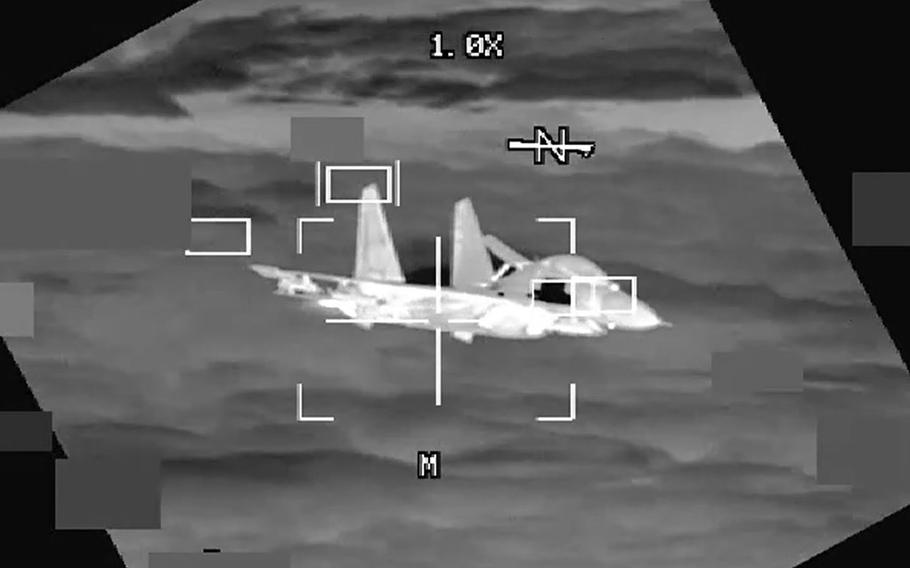
This screenshot of a video released by U.S. Indo-Pacific Command shows a Chinese J-11 fighter jet nearing a U.S. Air Force B-52 on Oct. 24, 2023, in what the command described as an “unsafe intercept.” (U.S. Indo-Pacific Command)
A Chinese fighter jet flew within 10 feet of a U.S. bomber over the South China Sea on Tuesday, an “unsafe and “unprofessional” maneuver made all the riskier because it happened at night, U.S. Indo-Pacific Command said in a news release Thursday.
The pilot of the J-11 fighter executed the “unsafe intercept” with a U.S. Air Force B-52 Stratofortress that was conducting routine operations in international airspace over the South China Sea, according to the release.
“During the night time intercept, the [Chinese] pilot flew in an unsafe and unprofessional manner, demonstrated poor airmanship by closing with uncontrolled excessive speed, flying below, in front of, and within 10 feet of the B-52, putting both aircraft in danger of collision,” the release said.
In such darkness and low visibility, it is possible the Chinese pilot could not assess how near his aircraft was to the bomber, according to the release.
“We are concerned this pilot was unaware of how close he came to causing a collision,” INDOPACOM said.
The flight route taken by the B-52 was not included in the release, but an undisclosed number of Stratofortresses deployed within the past week to Guam for a routine bomber task force mission.
Tuesday’s intercept was conducted “in a manner contrary to international air safety rules and norms,” the release said. “Military aircraft, when intentionally approaching another, shall operate with professional airmanship and give due regard for the safety of other aircraft.”
The near-miss is the latest in a sharp increase in risky behavior by Chinese pilots in the South China Sea, over which Beijing maintains broad claims of sovereignty that are disputed by neighboring nations.
On Oct. 17, the Pentagon released declassified images and videos depicting some of the roughly 180 incidents involving reckless maneuvers by Chinese pilots over the past two years.
“All [this is to try] to interfere in the ability of U.S. forces to operate safely in places where we and every country in the world have every right to be under international law,” Ely Ratner, the Pentagon’s assistant secretary of defense for Indo-Pacific security affairs, told reporters.
In response to the Pentagon’s disclosures, China’s Ministry of National Defense on Wednesday released video purporting to show the U.S. Navy guided-missile destroyer USS Ralph Johnson diverting its course to cross in front of a Chinese warship in the South China Sea on Aug. 19.
“This video proves that it is the US side that is making provocations, taking risks and muddling the water,” Senior Col. Wu Qian, spokesperson for the defense ministry, said at a news conference in Beijing.
“We have much similar video evidence, but I won’t show them today because of time constraints,” he said.
INDOPACOM said in its release that the U.S. will continue to “fly, sail, and operate — safely and responsibly — wherever international laws allow.”
“The U.S. Indo-Pacific Command Joint Force remains dedicated to a free and open Indo-Pacific region, and we expect all countries in the Indo-Pacific to operate in international airspace safely and in accordance with international law,” the release said.